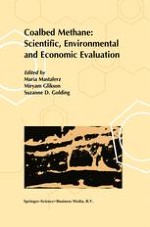1999 | OriginalPaper | Buchkapitel
Higher Hydrocarbon Gases in Southern Sydney Basin Coals
verfasst von : M. M. Faiz, A. Saghafi, N. R. Sherwood
Erschienen in: Coalbed Methane: Scientific, Environmental and Economic Evaluation
Verlag: Springer Netherlands
Enthalten in: Professional Book Archive
Aktivieren Sie unsere intelligente Suche, um passende Fachinhalte oder Patente zu finden.
Wählen Sie Textabschnitte aus um mit Künstlicher Intelligenz passenden Patente zu finden. powered by
Markieren Sie Textabschnitte, um KI-gestützt weitere passende Inhalte zu finden. powered by
Coal seams of the Sydney Basin contain large volumes of gas, mainly methane (CH4) and carbon dioxide (CO2) with subordinate amounts of heavier hydrocarbons (C2+). The desorbable gas content of the Sydney Basin coals ranges up to about 20 m3/t, and its abundance is mainly related to depth and geological structure.Gas isotope data indicate that most of the hydrocarbons presently occurring within the coal measures sequence was generated during coalification between the Permian and Late Cretaceous or as a result of post-Cretaceous bacterial activity, or both. Most of the CO2 was introduced into the sequence in association with intermittent igneous activity between the Triassic and the Tertiary.In the Sydney Basin coals, the CH4 content of the gas ranges up to 100% whereas the C2+ ranges up to 12% (by volume). A systematic variation in the various hydrocarbon components with depth is evident in most parts of the basin. Hydrocarbons, at depths shallower than about 600 m and close to the basin margins are essentially dry (depleted C2+). At greater depth, however, the quantity of C2+ in the gas increases regularly with depth up to 12% at about 1200 m. Carbon isotope data for the southern part of the basin show that CH4 becomes isotopically light towards shallower parts and close to the margins of the basin.Two different hypotheses are proposed to explain these variations in gas composition. One hypothesis emphasises the role of gas fractionation during migration due to variations in molecular diffusivity and solubility of the components. In this context, lighter and more rapidly diffusing components such as CH, can migrate readily to shallower depths and as a result the CH4/C2+ ratio is expected to increase towards the upper part of the sequence.However, in the Sydney Basin, such preferential migration cannot totally account for the abrupt scarcity of C„ at depths less than about 600 m. The lack of C2+ gases at < 500 m indicates that they may have been eliminated by a process which is confined to shallow depths. At these depths CH, is isotopically light (δ13C values range generally between –75‰ and –50‰ PDB) signifying a strong biogenic influence. Worldwide experience shows that biogenically formed gases are generally dry. Therefore, both the molecular and carbon isotope compositions indicate that in the Sydney Basin the lack of C2+ at shallow depths is probably due to bacterial alteration of the gases.
